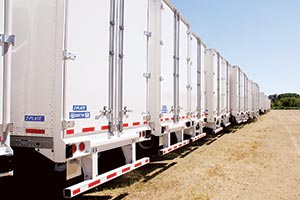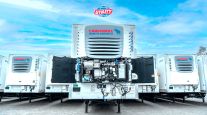Senior Reporter
Trailer Orders Drop 12% as Seasonal Slowdown Hits

This story appears in the June 27 & July 4 print edition of Transport Topics.
U.S. trailer orders fell 12% in May, reflecting typical seasonal demand, ACT Research Co. reported — though trailer manufacturers said the market had softened.
Orders dropped to 14,250, compared with 16,092 a year earlier, according to ACT.
“The expected seasonal slowdown in order placement has begun,” Frank Maly, ACT’s director of commercial vehicle transportation analysis, said in a statement.
The order total in May is typically a combination of softer orders along with some midyear adjustments to orders already booked with trailer manufacturers, according to ACT.
Year-to-date numbers reveal a steeper decline than May’s.
“I show 84,800 year-to-date orders for 2016 compared with 108,600 for the 2015 period. That’s about a 22% decline,” Maly told Transport Topics.
ACT said 2014, with 356,712 orders, and 2015 with 315,961, marked the two best years for trailer demand.
Research firm FTR said orders have totaled 286,000 units for the past 12 months. It pegged May’s total at 13,300.
“The market is starting to show some tiredness after a very impressive run,” Don Ake, FTR’s vice president of commercial vehicles, said in a statement.
Looking at May, David Giesen, vice president of sales for Stoughton Trailers, said, “We are back to normal ordering volumes, seasonally adjusted … that just means it is [one of] the lower intake months,” adding that May through August generate consistently lower orders for the dry van segment.
Asked if the top of the cycle had come, Giesen said, “I believe so. But again, just getting back to normal ordering volumes is not bad.”
Larry Roland, director of marketing for Utility Trailer Manufacturing Co., said the company is experiencing a similar seasonal situation.
“Historically, we see the bottom around the 4th of July week. We will be watching the weeks following closely to gauge the direction towards the end of the year,” Roland said.
May’s lower volume was “somewhat seasonal,” said David Gilliland, vice president of national accounts at Great Dane Trailers, “but many fleets have [also] made their 2016 purchases earlier than normal. They didn’t want to get left without slots.”
“The surprising part is that the [trailer] market stayed hot as long as it did,” said Glenn Harney, chief sales officer at Hyundai Translead.
But a slowdown is occurring now, he said, questioning whether it is a slump or just a move to normalcy.
“I can’t say,” Harney said.
FTR reported backlogs in May fell 9% year-over-year.
Meanwhile, orders for 2017 are in the very early stages, the manufacturers said.
Harney said Hyundai Translead has a “handful” of orders for 2017 and has not yet created an “actual schedule” for January.
Customers and Stoughton are talking about builds for 2017, Giesen said. “So far, it is shaping up as a normal year, but it is very early to make that call.”
Quotes and new orders are “softer than we have seen them in the last couple of years,” said Charles Willmott, chief sales officer at the Strick Group.
As to the root cause, Willmott said, “There are plenty of excuses to go around. I am sure everyone failing to meet expectations has their own pet angle.”
He suggested several: summer seasonality, declining imports, lower consumer confidence, a 10%-plus increase in original equipment manufacturers’ [trailer production] capacity and a driver shortage.
Despite more headwinds than the industry has faced in many months, “there is still plenty of opportunity out there for products and services that offer compelling value to the customer. We remain confident that that leaves the Strick Group in an excellent position now and in the future,” Willmott said.
Great Dane is beginning to look at 2017 slots and “expects to start filling them soon. We do expect this to be the peak, but do not see any significant drop-off in builds for 2017,” Gilliland said.
Michael Baudendistel, an analyst with Stifel, Nicolaus & Co., wrote in an investor note that the May order volume was in line with his expectations, “given commentary regarding [manufacturers] opening their 2017 order books earlier than normal.”
Also, FTR’s Ake said inventories have increased five straight months “and are getting somewhat elevated.”
Giesen said there are various methods of reporting inventory.
“As an industry, this gets reported differently, depending on the original equipment manufacturer — sold versus shipped, etc. I do not believe there is a glut of unsold inventory sitting in the market,” Giesen said.
ACT’s May figure was preliminary, and a final number will be published later in the month, Maly said.
FTR said its total was a final net number.




